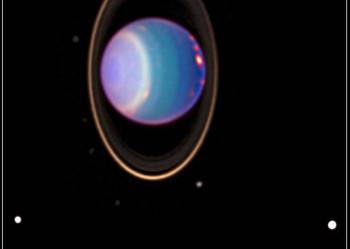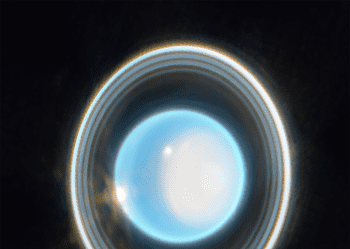
Uranus’ ring system isn’t nearly as spectacular as Saturn’s, but that doesn’t make them any less fascinating. Discovered very recently, in 1977, Uranus’ thin rings are impossible to discern with all but the largest telescopes. Using two such telescopes perched in the deserts of Chile, the Atacama Large Millimeter/submillimeter Array (ALMA) and the Very Large Telescope (VLT), astronomers have now revealed spicy insights about the planet’s rings, including the first measurement of their temperature.
The observations suggest that Uranus’ rings — 13 in total, from what we know — have a temperature of 77 degrees Kelvin (-196°C) or just about the boiling point of liquid nitrogen.
Uranus’ rings reflect only very little light in the visible and near-infrared spectrum, which has made observations so far incredibly difficult. Most of what we know about these rings is due to the Voyager 2 spacecraft which flew by the planet in 1986 and photographed them. Thanks to this mission we know that Uranus’ main rings lack dust-sized particles, and are instead composed of centimeter-sized or larger particles of sheets of dust.
“Saturn’s mainly icy rings are broad, bright and have a range of particle sizes, from micron-sized dust in the innermost D ring, to tens of meters in size in the main rings,” said Imke de Pater, a University of California Berkeley professor of astronomy. “The small end is missing in the main rings of Uranus; the brightest ring, epsilon, is composed of golf ball-sized and larger rocks.”

Epsilon, the brightest and densest ring of Uranus, is unique to the solar system, compared to structures in other known ring systems. Now, these new observations have magnified smaller features that weren’t visible until now, confirming that Epsilon and Uranus’ other rings are quite different, providing a big step forward towards understanding their composition and whether or not these rings come from the same source.
“The rings of Uranus are compositionally different from Saturn’s main ring, in the sense that in optical and infrared, the albedo is much lower: they are really dark, like charcoal,” graduate student Edward Molter said in a statement. “They are also extremely narrow compared to the rings of Saturn. The widest, the epsilon ring, varies from 20 to 100 kilometers wide, whereas Saturn’s are 100’s or tens of thousands of kilometers wide.”
“It’s cool that we can even do this with the instruments we have,” he said. “I was just trying to image the planet as best I could and I saw the rings. It was amazing.”
Uranus’ rings could be the result of asteroids captured by the planet’s gravity, fragments of moons that crashed into one another in ancient times, or debris from the time of the planet’s formation more than 4.5 billion years ago. Astronomers are set to find out more about Uranus’ rings once the upcoming James Webb Space Telescope’s advanced spectroscopes come into operation this decade.






